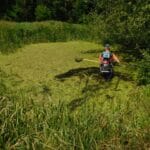Humans are living longer than ever before. Our expected lifespans have increased by 30 years in the last century alone. Scientists have long been focused on the concept of extending life, hoping for a miracle cure that will one day evade death. Many others are, however, choosing to focus on extending the value of our later years. Our bodies are still adapting to the extended lifetime. Now that people are living into their 80’s and even farther, humans are presented with a new challenge – how to make those extra 30 years worthwhile.
When the body ages, the portions responsible for our mobility – primarily joints – are targeted. Our joints are a complex network of soft tissues working together to provide us with a range of motion. Soft tissues deteriorate as the body gets older. Daily use causes inevitable wear, and this wear eventually causes pain as the cushioning effects of these soft tissues wane. People who have suffered from injury throughout their lives are more susceptible to this deterioration. Muscles and bone can also deteriorate over time, causing weakness and arthritis. There are a number of current solutions to deal with these age-related issues, though in some cases they may cause more harm than good.
In many cases, elderly patients are faced with expensive and invasive joint replacement surgeries. Surgery can have a large impact on a person’s lifestyle. They can cost tens of thousands of dollars, have long recovery periods and may involve physical therapy, limited mobility for a period of time, and costly medication to reduce pain. Many also turn to cortisone injections, which have to be repeated several times per year. One of the biggest issues with cortisone injection therapies is that they don’t treat the actual root causes of the pain and only reduce inflammation. In fact, cortisone can actually hasten the onset of arthritis by eroding the cartilage of joints. These current treatments are simply helping the symptoms, not addressing the underlying causes.
There are however, emerging advancements which are less invasive and more effective. These are called regenerative therapies. Regenerative Orthopedic and Spine therapies have been increasing in popularity over the past 10 years. Regenerative orthopedics are now becoming more favorable in many cases than traditional surgical interventions and cortisone injections.
When stem cells and platelet rich plasma are injected into a problem area, they are able to treat several types of tissue – cartilage, tendons, ligaments, bone and muscle among other things. These procedures can also reduce inflammation naturally.
Once a stem cell has latched onto a type of tissue, it begins growing new cells of that type of tissue. As these cells regenerate the damaged tissue, the pains caused by these tissues begins to decrease. For example, after a stem cell injection, the worn cartilage that is responsible for arthritis begins to grow back, reducing pain, improving mobility and allowing the joint to function properly again.
PRP, or Platelet-Rich Plasma is another type of treatment that has seen great results and may often times be more cost effective. It involves isolating platelets in a patient’s blood and injecting them into problem areas to heal them.
There are currently over 700 clinical trials underway that are testing the effectiveness of regenerative orthopedic treatments. Many studies find a high success rate, though it does take time for some patients to notice results.
As more studies on stem cell and PRP treatments are being done all over the world, scientists and doctors are gaining a solid clinical basis of how best to use these treatments to treat the ailments associated with an aging population. Stem cell and PRP treatments have the potential to make you much more comfortable, functional and active.
Senior Outlook Today is your go-to source for information, inspiration, and connection as you navigate the later years of life. Our team of experts and writers is dedicated to providing relevant and engaging content for seniors, covering topics such as health and wellness, finances, technology and travel.





